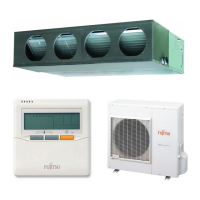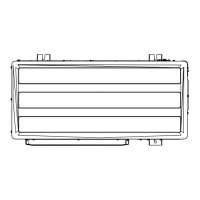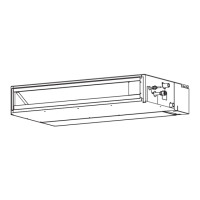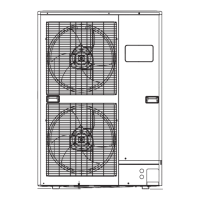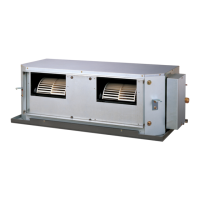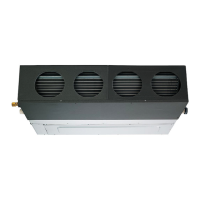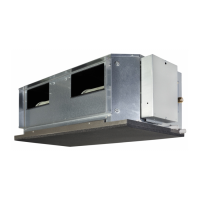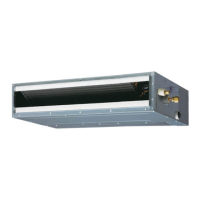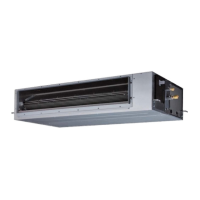3.3.3. Outdoor units installation in multi row (Unit : mm)
(1) Single parallel unit arrangement
150
600
1000
2000 or more
(2) Multiple parallel unit arrangement
500
600
1500
3000 or more
3.4. Transporting the unit
WARNING
Do not touch the ns.
Otherwise, personal injury could result.
CAUTION
When carrying the unit, hold the handles on the right and left sides and be careful.
If the outdoor unit is carried from the bottom, hands or ngers may be pinched.
Carry slowly in the manner as shown on “Fig. B” holding the handles “Fig. A” in right •
and left sides. (Be careful not to touch with hands or objects.)
Be sure to hold the handles on the sides of the unit. Otherwise, the suction grilles on •
the sides of the unit may be deformed.
Fig. A
Handle
Suction grille
Handle
Suction grille
Fig. B
Front view
Rear view
3.5. Installation
(Unit : mm)
4 - Φ 12 Hole
132
AIR
650 119
50 50
16
370
Install 4 anchor bolts at the locations indicated with arrows in the above gure.•
To reduce vibration, do not install the unit directly on the ground. Install it on a secure •
base (such as concrete blocks).
The foundation shall support the legs of the unit and have a width of 50 mm or more.•
Depending on the installation conditions, the outdoor unit may spread its vibration •
during operation, which may cause noise and vibration. Therefore, attach damping
materials (such as damping pads) to the outdoor unit during installation.
Install the foundation, making sure that there is enough space for installing the •
connection pipes.
Secure the unit to a solid block using foundation bolts. (Use 4 sets of commercially •
available M10 bolts, nuts, and washers.)
The bolts should protrude 20 mm. •
(Refer to the gure below.)
If overturning prevention is required, purchase the necessary commercially available •
items.
Bolt
20 mm
Nut
Base
Fix securely with bolts on a solid block. (Use 4 sets of commercially available M10 bolt,
nut and washer.)
4. PIPE SELECTION
4.1. Selecting the pipe material
CAUTION
Do not use existing pipes.
Use pipes that have clean external and internal sides without any contamination which
may cause trouble during use, such as sulfur, oxide, dust, cutting waste, oil, or water.
It is necessary to use seamless copper pipes.
Material: Phosphor deoxidized seamless copper pipes.
It is desirable that the amount of residual oil is less than 40 mg/10 m.
Do not use copper pipes that have a collapsed, deformed, or discolored portion
(especially on the interior surface). Otherwise, the expansion valve or capillary tube may
become blocked with contaminants.
Improper pipe selection will degrade performance. As an air conditioner using R410A
incurs pressure higher than when using conventional refrigerant, it is necessary to
choose adequate materials.
Note:
Thicknesses of copper pipes used with R410A are as shown in the table.
Never use copper pipes thinner than those indicated in the table even if they are available
on the market.
Thicknesses of Annealed Copper Pipes (R410A)
Pipe outside diameter
[mm (in.)]
Thickness
[mm]
6.35 (1/4)
0.89.52 (3/8)
12.70 (1/2)
15.88 (5/8) 1.0
19.05 (3/4) 1.2
4.2. Protection of pipes
Protect the pipes to prevent the entry of moisture and dust.
Especially, pay attention when passing the pipes through a hole or connecting the end of
a pipe to the outdoor unit.
Location Working period Protection method
Outdoor
1 month or more Pinch pipes
Less than 1 month Pinch or tape pipes
Indoor - Pinch or tape pipes
4.3. Refrigerant pipe size and allowable piping length
CAUTION
Keep the piping length between the indoor unit and outdoor unit within the allowable
tolerance.

